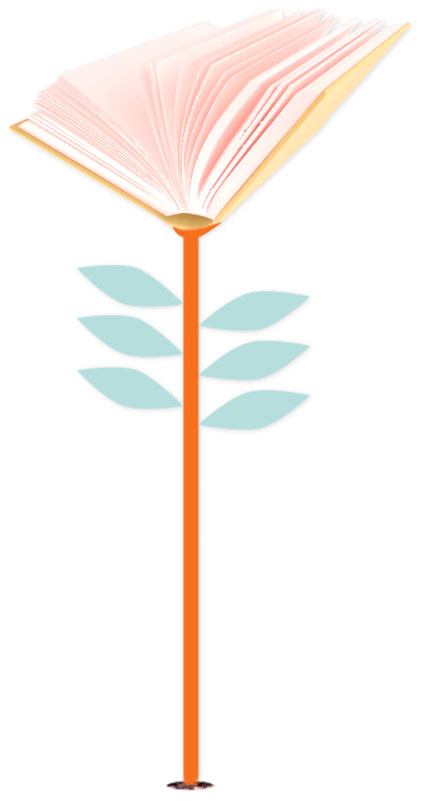Librarian Leads Reading Garden Project
Missouri elementary school library media specialist Carly Bogaards helps promote education, wellness, and community with an expanding outdoor program.
 |
Students work in the school’s garden.Photo courtesy of Carly Bogaards; SLJ Montage: Getty Images |
Third-graders at Liberty Oaks Elementary in Kansas City, MO, are literally planting the seeds of sustainability and generosity. As part of the school’s Garden Project, they’re creating a seed library for home gardeners and developing a reading garden for their school.
“It’s a way for our school and our kids to promote education, wellness, and community,” says Carly Bogaards, library media specialist at Liberty Oaks.
When she proposed the seed library, her principal suggested adding an outdoor classroom. Bogaards, who also runs the school’s Garden Club, decided to combine the concepts “and make this really cool reading garden,” with seating, play areas, and gardening-related books available for students.
“I’m really excited about having comfy spots and having an experience for reading,” Bogaards said.
A few years ago, when the school’s garden was restarted after COVID-19 shut it down, students chose seeds for the five raised beds that sit in a quiet area between the two wings of the school building. Bogaards bought the seeds from Kansas City Community Gardens, which partners with schools starting gardens.
Students planted the seeds—sweet potatoes, tomatoes, peppers—and learned how to care for them as they grew. Current plants include carrots, broccoli, lettuce, and radishes. In one of Bogaards’s favorite moments, the students had to figure out what was eating their broccoli.
“It was really fun to narrow it down, like a mystery,” she says. Once they determined that deer were the culprit, the students devised ways to keep the deer away.
“Kids thought it was so cool to go out with their iPads and take pictures of the teeth marks,” Bogaards says. “Did they see any footprints and, oh, there’s a fence around the school, what kind of animals could fit in?” Next steps: “Narrowing it down and going through the design process [to figure out] what to do to stop it.”
Most of the students had never gardened before, so Bogaards and a fellow teacher taught them about growing, pruning, weeding, and harvesting.
 While the students loved digging in the soil, Bogaards says the best part was harvesting day. “It’s so funny how proud the kids get when we harvest and get to eat” the sweet potatoes, tomatoes, and peppers they’ve grown. “Some of these kids have never tried any of these vegetables, so that was really fun to see them try a new vegetable for the first time.” They used the produce to make sweet potato fries and salsa.
While the students loved digging in the soil, Bogaards says the best part was harvesting day. “It’s so funny how proud the kids get when we harvest and get to eat” the sweet potatoes, tomatoes, and peppers they’ve grown. “Some of these kids have never tried any of these vegetables, so that was really fun to see them try a new vegetable for the first time.” They used the produce to make sweet potato fries and salsa.
The students launched the seed library by researching what plants would thrive in their area and how to care for them, then using that information to create an app on their school website so parents and community members can select free seeds. As their plants grow at home, they can send seeds back to the seed library for others to use.
For the reading garden, the third graders designed what they wanted the reading area to look like, including an accessible reading playhouse with a mini library; hammocks and other seating; connecting poles so kids can build their own forts; and an outdoor classroom area.
Students in the Construction Science Club at Liberty High School used those designs to create a plan for the playhouse, incorporating the third graders’ feedback, and began to build with the younger students’ assistance. Professional roofers guided the high schoolers, who worked to help the third-graders put in nails. Bogaards says they all learned “how to build a house from the ground up. It’s been really cool to have that hands-on experience.”
The playhouse exterior, hammocks, and fort structures will be completed by the end of 2025. The students—fourth graders by then—will research circuitry and renewable resources in order to add solar panels to provide electricity for the reading shed. They plan to install exterior lighting around the entrance and throughout the garden for better visibility.
Bogaards has other plans for the future, as well. “We’re going to be growing tomato seeds that have actually been up in space” and comparing them to regular seeds. Students won’t know which one is which, but they’re excited to guess.
Bogaards hopes to add recipes, a cooking show, or stories from the garden, as well as book recommendations on an app accessible via the school website, which will launch next year.
“In the future, we’d love to do a market of some sort, where we can sell produce to our community or give to local members around our community.”
Bogaards also plans to use the garden for family-friendly events during and after school.
She expects the playhouse and reading garden to be a three-year project, completed in Spring 2027, but teachers should be able to use the reading garden by Spring 2026. At that time, students from all grade levels will be able to sign up for a time slot to read outside. Each grade will take ownership of different areas, like the potted plants or garden beds.
Bogaards said that when author Meg Medina came to speak at the school this year, “she said something that stuck with me, which was ‘Reading should be an experience.’” That’s the goal for this garden. Bringing students out into nature is good for their mental health; it allows them to have “that experience with their friends of just sitting in a hammock and reading for fun.”
But the students are already having fun. Bogaards said they constantly ask when they get to go into the garden.
“I love how the community’s coming together and how our students are just really, really excited about the project.”
Marlaina Cockcroft is a freelance writer and editor.
RELATED
The job outlook in 2030: Librarians will be in demand
The job outlook in 2030: Librarians will be in demand
ALREADY A SUBSCRIBER? LOG IN
We are currently offering this content for free. Sign up now to activate your personal profile, where you can save articles for future viewing






Add Comment :-
Be the first reader to comment.
Comment Policy:
Comment should not be empty !!!